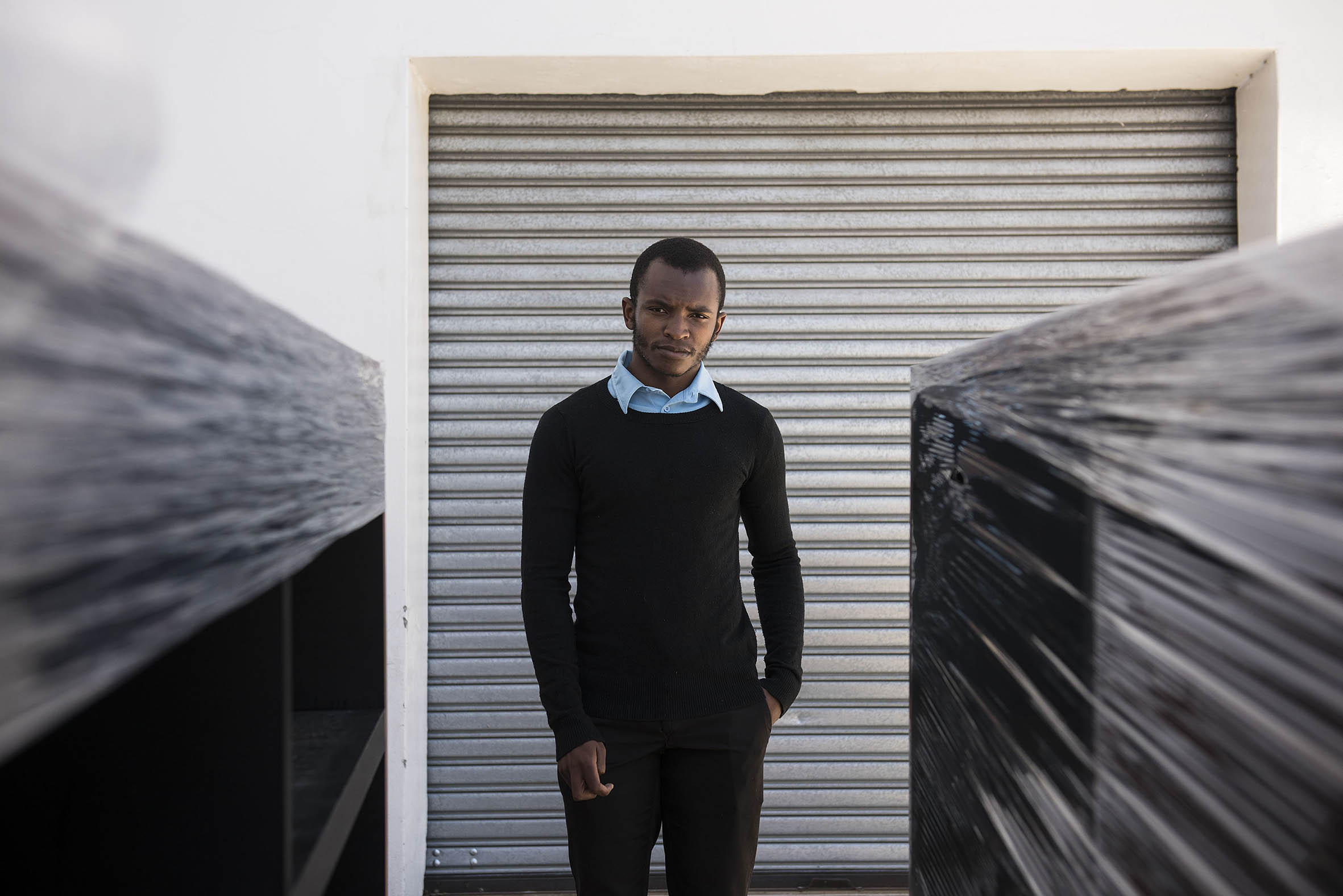Triple isolation: Jade Gibsons mother was killed by her stepfather. She says silence about domestic violence and femicide leads to silence about it when children grow up. (David Harrison/M&G)
Feels like I’ve been here before
All things don’t seem the same no more
Although I know I’m my mother’s child
I gotta break free into the wild. — Father’s Child, Michael Kiwanuka
It was about 4.30pm. He’d been at work when, responding to the two missed calls from his landlord, Garfield Bhembe was told to “come home now” because “something tragic has happened”.
“I asked him what was wrong, but he said he can’t tell me over the phone,” says Bhembe. “But, in the back of my mind I kind of knew what had happened. My instincts just told me that something had happened to my mom.”

Garfield Bhembe (David Harrison/M&G)
His intuition was correct. His mother’s body had been discovered with multiple stab wounds. To her cheeks. Her temple. Her right eye. Her lower jaw.
Murdered by his father, his mother is just one of the many South African women killed at the hands of their intimate partner — making Garfield and his 14-year-old sister two of thousands of children directly affected by this kind of violence.
“I was heartbroken. It was bad. When I got here, there were people I don’t know outside the house. They sat me down and said ‘your mom is gone’. It broke me, you know. My mom was so special to me. She was the closest thing I had in life. She was my everything,” Bhembe says.
One woman is murdered every eight hours by their intimate partner in South Africa, according to Africa Check, a non-profit independent fact-checking organisation.
Shaheda Omar, the director of the Teddy Bear Clinic, says children affected by femicide suffer from post-traumatic stress disorder, which manifests as depression, anxiety, aggression and a sense of isolation.
“You would, for example, find them having startle responses, avoidance of situations or settings that would remind them of the trauma as well as avoidance of certain individuals. They would also be plagued by intrusive symptoms, such as recurrent flashbacks and nightmares.”
They may also show little interest in activities they previously enjoyed and “plummeting grades at school” as well as “excessive fear without sometimes being able to identify where that source of fear is coming from”.
Omar adds that it is also common for these children to suffer psychosomatic symptoms. “There would maybe be unexplained headaches or stomach aches. When a child is being attended to by a medical doctor and there isn’t a medical diagnosis for that physical complaint. But if one goes and unpacks it with a psychiatrist or psychologist, it makes perfect sense why the child is presenting with these kinds of symptoms.”
These symptoms, along with social withdrawal and isolation as a result of “a sense of hopelessness and helplessness” are “actually a normal response to an abnormal situation”.
Omar says boys and girls react differently under these circumstances.
Suicide ideation and attempts are more prevalent among girls, whereas boys have more aggressive outbursts.
“Generally, males externalise it, while females internalise,” she says.
“Your life wasn’t wasted, Mum, I tell myself … This is the start of a new journey, and all I want to do is live, live, live, to give meaning to Mum’s life.” — Excerpt from Glowfly Dance
After years of internalising, Jade Gibson wrote Glowfly Dance, in which she reveals how, at the age of 14, she also became a child affected by femicide.
“My whole family was destroyed,” she says. Describing her mother’s death at the hands of her stepfather as “a shock, but also not a shock”, Gibson says that, as a child living in a violent household, “you just always knew it was possible”.
“You are always expecting that day where she is just not going to walk out of it, you know? You live with that fear.”
Gibson says, if there been greater support from those who knew about the domestic violence taking place in her family home, her mother’s murder could have been prevented.
“I always felt it was preventable. Not by me personally, but by the people around her who knew what was going on.”
After her mother’s death, she says: “There was no sense that people understood what had happened. There was no counselling, people didn’t talk about it because they didn’t know how to. The adults were almost embarrassed; they just didn’t know how to handle it.”
Gibson calls this a “triple sense of isolation”. “First, you’re growing up with this violence. Then, when it happens, nobody is really talking about it because they don’t know how to handle it. Then, you end up not wanting to tell anyone because you either don’t think anyone would understand or you don’t want to be treated as a victim.”
Clinical psychologist Itumeleng Mamabolo says “it’s complicated” for children in these situations because they often find it difficult to talk about what happened. “There is generally a feeling that the parents are a reflection of them, so there is a sense of shame carried by the child themselves for something they were not responsible for.”
Omar agrees: “Often children take on enormous responsibility. So, when things don’t work out in their family or home situation, often they feel responsible. They feel that it is perhaps something they have done wrong or could have done differently. Internal dialogues in which they bargain with themselves: ‘If only I had done this; if only I had helped or protected mum’. So they take on all this blame and shame for everything that has gone wrong,” she says.
Omar says children exposed to such violence often replicate what they have experienced by becoming victims or perpetrators of violence.
But, she adds, social media campaigns and awareness-raising initiatives are providing people with “opportunities to see and say that not all relationships work like that. There are opportunities being created for children to react differently and to actually want to shift this.
“It’s about the availability of resources both internally and externally. It’s about what support structures they have, and what access they have to support that would make an impact and shift the trajectory of that child.”
Mamabolo adds: “They need professional intervention in order to have the language and the tools to make sense of things.”
I am my mother’s child
Walk with me
Show me pure affection
Walk with me
Show me the right direction
I am my father’s child.— Michael Kiwanuka
For now, Bhembe is clinging to the religious beliefs instilled in him by his mother to make sense of her brutal murder.
“If I may tell you,” he says, “before this happened, my mom went on a 21-day fast. She finished on the Saturday before it happened. And she told me: ‘Garfield, I am fasting for peace. I need peace.’ She wanted an answer from God. She wanted God to come through for her and say, ‘I’ll give you this peace you are longing for.’Because she couldn’t do it anymore. She couldn’t stay married to my father.
“So I’m just going to continue living by what she taught me: never to forget who your heavenly Father is, because he is going to bring you out of any sort of situation.
“Our Father… our heavenly Father,” he stresses, correcting himself, “would never bring us down.”
The ultimate betrayal
Half of all murders of women are carried out by their partners and South Africa has the highest rate of those, according to a 2015 policy brief by the Alan J Flisher Centre for Public Mental Health.
This is not new. In 2004, the South African Medical Research Council said that every six hours a woman is killed by her partner. Its 2012 follow-up study reflected a decrease, in line with the general decrease in murder rates.
But a woman still dies every eight hours at the hands of her partner, who can be a (former) husband or (former) boyfriend.
A Statistics South Africa health survey published last week revealed that 21% of women over 18 in South Africa have experienced violence at the hands of their partner.
These studies confirm that black African women from rural areas, and in lower-income families, are at the greatest risk of intimate partner violence. The most dangerous moment for a woman trapped in a violent relationship is when she leaves the partner. — Ruth Hopkins
Carl Collison is the Other Foundation’s Rainbow Fellow at the Mail & Guardian
